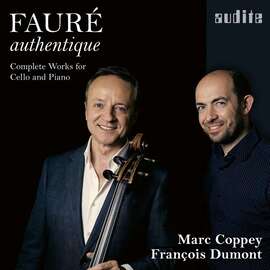Marc Coppey rahmt die beiden Cellosonaten von Gabriel Fauré mit kleineren Stücken aus der Gattung der Salonmusik, wie sie Gabriel Fauré liebte. Der Komponist war oft im Salon der Princesse Edmond de Polignac-Singer zu Gast, mit der er eng befreundet war, sowie in jenem von Marguerite de Saint-Marceaux, der Frau des Bildhauers René de Saint-Marceaux, am Boulevard Malesherbes, wo Fauré seinen Schüler Maurice Ravel in die Pariser Gesellschaft einführte.
Man kann diese kleineren Stücke, die eher das Spiegelbild eines zarten und poetischen Temperaments sind als das Produkt einer starken und ausgeprägten Persönlichkeit, wie Süßigkeiten verzehren. In Schönheit. Manchmal auch träumend. Die Frische, mit der Coppey und Dumont spielen, bringt zudem eine gute vitale Qualität in die Musik. Die Interpretationen sind gut strukturiert und bewundernswert ausgewogen.
Die beiden Sonaten für Violoncello und Klavier gehören zum Spätwerk von Gabriel Fauré, in dem dieser Hauch von Salonmusik, der Faurés Kompositionen lange Zeit beeinträchtigte, völlig verschwunden ist.
Die Interpretationen werden Faurés festerer Handschrift und den ihn beeinflussenden äußeren Umständen – Kriegswirren, Krankheit – gerecht und nutzen gleichzeitig die harmonischen Raffinessen der beiden Werke voll aus. Die beiden Interpreten bemühen sich in flüssigem Spiel erfolgreich, die Beredsamkeit der Musik aufrecht zu erhalten und jegliche Monotonie verhindern.
Marc Coppey frames the two cello sonatas by Gabriel Fauré with smaller pieces from the genre of salon music that Gabriel Fauré loved. The composer was a frequent guest at the salon of Princess Edmond de Polignac-Singer, with whom he was close friends, as well as at the salon of Marguerite de Saint-Marceaux, wife of the sculptor René de Saint-Marceaux, on the Boulevard Malesherbes, where Fauré introduced his pupil Maurice Ravel to Parisian society.
These small pieces, which reflect a delicate and poetic temperament rather than a strong and distinctive personality, can be consumed like sweets. In beauty. Sometimes even like in a dream. The freshness with which Coppey and Dumont play also brings a good vitality to the music. The interpretations are well structured and admirably balanced.
The two sonatas for violoncello and piano are among the late works of Gabriel Fauré, in which the touch of salon music that for a long time marred Fauré’s compositions has completely disappeared.
The interpretations do justice to Fauré’s firm style and the external circumstances that influenced him – the turmoil of war, illness – while at the same time making full use of the harmonic refinements of both works. The two performers succeed in preserving the eloquence of the music and avoiding any monotony in their fluid playing.


















